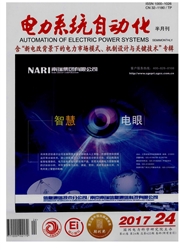

 中文摘要:
中文摘要:
建立了光伏发电系统、风力发电系统和微型燃气轮机发电系统(MTG)3种典型微电源的数学模型和仿真模型,基于MATLAB Simulink仿真平台分析比较了各单微电源构成的微电网的运行特性,得到了不同微电源的动态响应特点。进而对3种微电源组成的微电网的运行特性进行了仿真分析,仿真考虑了并网运行状态切换至孤网运行状态的过渡过程以及孤网时的负荷扰动。进一步的仿真分析表明,不同微电源的容量对微电网孤网电压水平具有不同的影响,其中MTG存在"最优容量",该容量对应的微电网并网切换至孤网时电压下降百分比最小。该结论是微电网规划阶段微电源容量配置的重要依据。
 英文摘要:
英文摘要:
A microgrid includes many kinds of microsources, such as photovotaic (PV), wind turbine generator (WTG), mocroturbine generator (MTG), etc., with different characteristics. The mathematical models and simulation models of these 3 typical microsources are built, and the operation features of different microgrids with single microsource are analyzed on the platform of MATLAB Simulink, based on which different dynamic response characteristics of different microsources are obtained. The operation characteristics of microgrids with all the 3 microsources are studied, and various operation conditions and disturbances are considered during the simulation, such as disconnection from the distribution power grid, load changes in the islanded mode, etc. Further more, different microsources have different influences on the voltage level of the microgrid, e.g. there is an optimal capacity for MTG, which corresponds to the minimum voltage drop percentage of the microgrid from connected to islanded mode. The optimal capacity is an important basis for the microsources capacity configuration during the planning stage of microgrid.
 同期刊论文项目
同期刊论文项目
 同项目期刊论文
同项目期刊论文
 Capacitors dispatch for quasi minimum energy loss in distribution systems using a loop-analysis base
Capacitors dispatch for quasi minimum energy loss in distribution systems using a loop-analysis base SMES-Battery Energy Storage System for Conditioning Outputs from Direct Drive Linear Wave Energy Con
SMES-Battery Energy Storage System for Conditioning Outputs from Direct Drive Linear Wave Energy Con 期刊信息
期刊信息
